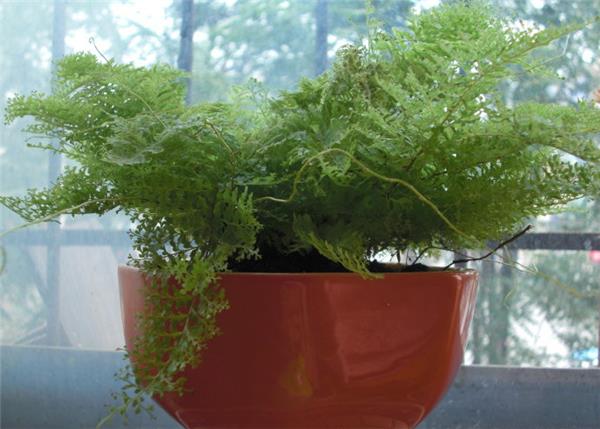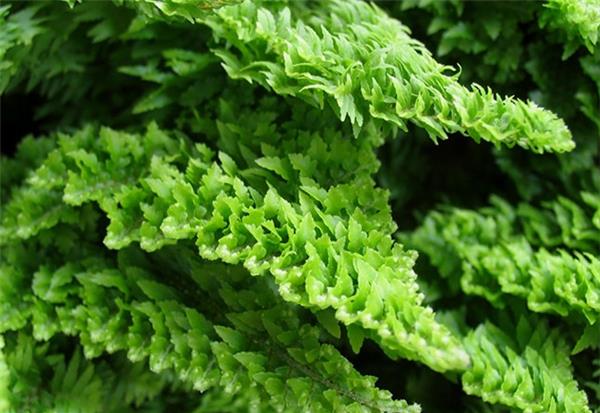The function of Boston fern culture method
The Boston fern is beautiful in shape and has a faint smell of grass. If its foliage is good, it is a very healthy bright green, which makes people feel refreshed and refreshed, and can play a role in relieving visual fatigue, so it is very suitable for home farming.

1. Morphological characteristics of Boston fern.
It belongs to perennial evergreen fern herbs. Rhizome erect, stoloniferous. The leaves are tufted, up to 60 cm long, with slender compound leaves, the leaves spread and droop, the leaves are bipinnately parted, and the pinnae are auriculate at the base. The sporangium is semicircular, born on the back of the leaf near the edge of the leaf.
This plant is a kind of drooping fern foliage plant, which is suitable for potted indoor hanging and ornamental, and its stolon cutting can be used as a decorative material.
2. The growth habits of Boston fern
Boston ferns are generally cultivated in bright scattered light indoors and cannot be exposed to bright light, but they cannot be cultivated in the dark either. The suitable temperature for growth is 15-25 ℃, and it can survive the winter safely when it is above 10 ℃ in winter. Although the Boston fern is drought-resistant, it still needs plenty of water, and it should not be too wet or too dry. Keep the basin soil moist frequently. In summer, water is watered once or twice a day, often spraying water to the leaves. Boston fern does not need much fertilizer. During the growing period, thin rotten cooked cake fertilizer should be applied every 4 weeks. Quick-acting chemical fertilizer should not be used. Do not stain the leaves when fertilizing, so as to avoid damage.

Third, the function of Boston fern
1. Ornamental value
Boston fern, perennial evergreen fern herb, is a kind of drooping fern foliage plant, which is very suitable for potted indoor hanging and ornamental plants, and has high ornamental value. Boston fern likes shade, strong adaptability, easy cultivation, more suitable for indoor perennial pot ornamental.
two。 Decoration Home Furnishing
Boston fern can also decorate the home and beautify the home environment. Boston fern has beautiful stems and leaves, beautiful shape and small plant type, which is very suitable for small pot cultivation and bonsai culture. Potted Boston fern is used to decorate bright living room, conference room, study and bedroom.
3. Purify the air
Boston fern can purify the air and absorb indoor harmful gases such as xylene, toluene and formaldehyde, especially for formaldehyde. Boston fern absorbs about 20 micrograms of formaldehyde per hour, so it is considered to be the most effective biological "purifier", so it is perfect to raise Boston fern in a newly renovated new house. Boston ferns can inhibit the release of xylene and toluene from computer monitors and printers. People who deal with paints and paints all day long, or those around people who like to smoke, should keep at least one pot of Boston ferns in the workplace.
4. Humidifying ability
Boston fern is a variety of kidney fern, which is highly adaptable, has the function of absorbing formaldehyde waste gas, and can inhibit xylene and toluene released from computer monitors and printers, so it is an effective biological purifier. Boston fern is a very recommended plant. In addition, the advantage of cultivating Boston fern lies in its humidifying ability and its positive effect on people's psychology. Fresh green leaves can make people feel the smell of spring throughout the year, making people relax.

IV. Culture and nursing methods of Boston fern
1. Reproduction: the Boston fern is often propagated by the split-plant method. In summer, the rooted plantlets from the stolon are cut off from the vigorous plants and planted separately.
two。 Soil: potted Boston fern is suitable to choose the mixed culture soil of rotten leaf soil, river sand and garden soil, and the growth is better when water moss is used as culture medium. Change the basin every other year in the spring.
3. Lighting: Boston fern likes bright scattered light, it is appropriate to put it indoors with bright scattered light in spring and summer, when the sun is strong, the leaves will turn yellow; in winter, the light should be increased appropriately, otherwise the leaf color will turn yellow or cause the leaf edge to dry up.
4. Watering: Boston ferns like humid environments and require high soil and air moisture. Because the roots of Boston fern are adventitious roots, the ability to absorb and retain water is poor, so water must be supplied in time, otherwise drying for too long will easily lead to withered and yellow leaves. The basin soil in spring and summer should always remain moist, but it should not be too wet. It is better to keep the basin soil moist frequently. Besides timely watering, it is also necessary to spray water to the foliar surface in summer. When the room temperature is low in winter, you should reduce watering and keep the soil slightly moist.
5. Fertilization: the fertilization concentration of Boston fern should not be too high, otherwise it is easy to hurt the roots. the best way of fertilization is to add rotten barnyard manure first when loading the pot (changing the basin every other year in spring), and then topdressing with thin fertilizer in the peak growing season. When applying fertilizer, it is necessary to avoid contamination of the leaves. If it is accidentally contaminated, it should be washed with clean water immediately.

Well, after reading the above introduction, do you know how to breed Boston ferns? The home of Boston fern plays a great role, especially suitable for newly renovated rooms, which can help absorb harmful gases from new rooms, so if you are interested, you can try to raise them.
Rinse with clean water immediately.

Well, after reading the above introduction, do you know how to breed Boston ferns? The home of Boston fern plays a great role, especially suitable for newly renovated rooms, which can help absorb harmful gases from new rooms, so if you are interested, you can try to raise them.
Related
- Wuhan Hospital Iron Tree Blooming Result Was Instantly Frightened by the Gardener Master
- Which variety of camellia is the most fragrant and best? Which one do you like best?
- What is the small blue coat, the breeding methods and matters needing attention of the succulent plant
- Dormancy time and maintenance management of succulent plants during dormancy
- Minas succulent how to raise, Minas succulent plant pictures
- What are the varieties of winter succulent plants
- How to raise succulent plants in twelve rolls? let's take a look at some experience of breeding twelve rolls.
- Attention should be paid to water control for succulent plants during dormant period (winter and summer)
- Watering experience of twelve rolls of succulent plants
- Techniques for fertilizing succulent plants. An article will let you know how to fertilize succulent plants.



